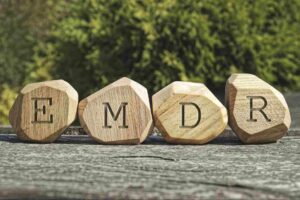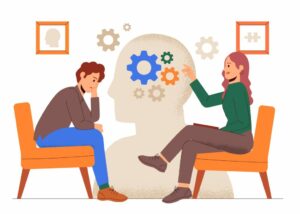Depression is an ailment that, for many, can feel like an ever-present shadow, diminishing the vibrancy of life. Traditional treatment methods, such as cognitive-behavioral therapy and medication, have proven effective for countless individuals. Yet, for some, the journey to relief requires an alternative approach. Enter Eye Movement Desensitization and Reprocessing (EMDR) – a therapeutic modality initially designed to treat traumatic memories, but which has shown promise in addressing a broader spectrum of mental health issues, including depression. This article will delve deep into how EMDR works, its potential benefits for those grappling with depression, and what to expect during sessions.
Contents
Is EMDR Helpful In Depression?
 Absolutely, EMDR (Eye Movement Desensitization and Reprocessing) therapy, originally developed to treat traumatic memories, has shown potential in addressing not just trauma but also other mental health disorders, including depression. While the primary focus of EMDR has been on post-traumatic stress disorder (PTSD). Still, several studies and clinical reports have indicated its effectiveness in alleviating depressive symptoms.
Absolutely, EMDR (Eye Movement Desensitization and Reprocessing) therapy, originally developed to treat traumatic memories, has shown potential in addressing not just trauma but also other mental health disorders, including depression. While the primary focus of EMDR has been on post-traumatic stress disorder (PTSD). Still, several studies and clinical reports have indicated its effectiveness in alleviating depressive symptoms.
The therapy’s unique approach, which involves processing distressing memories with bilateral stimulation (typically guided eye movements), can help individuals reframe negative beliefs and reduce the emotional charge associated with distressing memories. This can contribute to or exacerbate depression. It’s important to note, however, that while EMDR can be effective for some individuals with depression, its efficacy might vary based on the individual’s unique circumstances and the underlying causes of their depression.
How Does EMDR Therapy For Depression Work?
EMDR therapy for depression is a specialized form of psychotherapy. Here’s how EMDR works, especially in the context of depression:
Bilateral Stimulation
This involves activating both hemispheres of the brain in a rhythmic manner, typically using guided eye movements. A client, under the guidance of a therapist, will be asked to recall a distressing memory while simultaneously following the therapist’s fingers as they move horizontally back and forth in the client’s field of vision. It’s believed that this process facilitates the brain’s natural healing mechanism, helping it to reprocess distressing memories. While the most common method is visual (eye movements), other forms like auditory (alternate beeps in each ear) or tactile stimulation (alternate tapping) can also be used depending on the client’s comfort and the therapist’s recommendation.
Processing Distressing Memories
Depression often carries with it a cache of distressing memories or events that may be contributing to an individual’s current emotional state. EMDR provides an avenue for individuals to confront and reprocess these memories. By reducing the emotional intensity of these memories, they become less overpowering and debilitating. The aim is not to erase memories but to desensitize the emotional charge linked to them, enabling individuals to recall them without the same level of distress.
Reframing Negative Beliefs
One significant aspect of depression is the entrenchment of negative self-beliefs. Such beliefs might include thoughts like “I’m a failure,” “I’m unlovable,” or “I’m not good enough.” During EMDR therapy, these negative cognitions are identified and challenged. The bilateral stimulation aids in helping the individual replace these with more positive, constructive beliefs. Over time, as these positive beliefs are reinforced, they can contribute to an improved mood and outlook on life.
Eight Phases of EMDR
 EMDR therapy is methodically structured around eight phases to ensure comprehensive treatment:
EMDR therapy is methodically structured around eight phases to ensure comprehensive treatment:
- History-taking and treatment planning: This phase involves a deep dive into the client’s history. It helps the therapist understand the root causes and decide which traumatic events or memories need to be targeted.
- Preparation: This is a foundational phase where the therapist establishes trust with the client. The client is also taught various self-soothing techniques, preparing them for the intensive processing phases.
- Assessment: Here, specific target memories are pinpointed, along with the negative beliefs associated with them.
- Desensitization: This is the core phase where memories are reprocessed using bilateral stimulation until they lose their distressing edge.
- Installation: With the distressing edge gone, positive, adaptive beliefs are introduced and reinforced.
- Body Scan: After processing memories, the therapist checks for any residual physical tension, ensuring that distress has been fully addressed.
- Closure: This phase ensures the client returns to a state of equilibrium after the session, feeling grounded and safe.
- Reevaluation: In subsequent sessions, the therapist revisits treated memories to ensure their effective processing and makes adjustments if needed.
Adapting to Individual Needs
Each person’s experience with depression is unique, and as such, EMDR therapy might require customization to address individual needs. A trained EMDR therapist will be skilled in understanding when to stick to standard protocols and when adaptations might be more beneficial. Some clients might need more extended preparation phases, while others might require deeper work on specific traumatic events.
Therefore, EMDR therapy for depression offers a structured yet adaptable approach by targeting its root causes, processing distressing memories, and reframing negative beliefs. With a trained professional, this therapeutic modality can be a transformative journey toward healing.
What To Expect With A Therapy Session?
Undergoing therapy, especially for the first time, can be a daunting experience. Knowing what to expect can alleviate some of the anxiety associated with the process. Here’s a breakdown of what typically occurs during a therapy session:
Intake and Assessment
- First Session: Your initial session will often be slightly different from subsequent ones. It’s primarily about information gathering for the therapist and setting the groundwork for future sessions.
- Discussion of History: You’ll be asked about your current concerns, mental and medical history, and any significant life events or changes.
- Goals for Therapy: You and the therapist will discuss what you hope to achieve or address during your sessions.
Building a Therapeutic Relationship
- Establishing Trust: One of the essential elements of successful therapy is the relationship between the client and the therapist. It’s crucial to feel safe and trust your therapist.
- Open Communication: It’s a space for you to express your feelings, concerns, and challenges openly. The therapist will encourage communication, provide feedback, and offer guidance.
Therapeutic Interventions
- Techniques and Strategies: Depending on their training and your needs, therapists will employ various therapeutic techniques, ranging from cognitive-behavioral strategies to psychodynamic approaches.
- Homework Assignments: Sometimes, therapists may give “homework” or tasks to complete outside of sessions. These tasks are designed to reinforce therapeutic techniques or to encourage self-reflection.
Processing Emotions and Experiences
- Sharing and Reflecting: During sessions, you’ll be encouraged to discuss your feelings, experiences, and memories. The therapist will help you process these, providing insights and coping strategies.
- Emotional Release: Therapy can sometimes be emotionally intense. It’s a space where it’s okay to cry, express anger, or confront difficult feelings.
Review and Adjust Goals
- Regular Check-ins: As therapy progresses, it’s standard for therapists to review the goals set during the initial sessions.
- Reassessment: Depending on the progress and any new challenges, goals might be adjusted or new ones set.
Closure and Termination
- End of Session: Each session typically ends with a brief summary and discussion of the next steps or topics for the upcoming session.
- End of Therapy: Once therapeutic goals are met or significant progress is achieved, you and your therapist might discuss ending regular sessions. This discussion includes how to maintain the progress made and potential follow-up sessions if needed.
Remember, individual experiences can vary based on the therapist’s approach, the therapeutic modality being used, and the individual’s unique needs. It’s essential to maintain open communication with your therapist to ensure the process is beneficial and tailored to your requirements.
What Are The Benefits Of EMDR Therapy For Depression?
 EMDR (Eye Movement Desensitization and Reprocessing) therapy, originally developed to treat trauma and PTSD, has shown promise in the treatment of depression. The following are the key benefits of EMDR therapy when used for depression:
EMDR (Eye Movement Desensitization and Reprocessing) therapy, originally developed to treat trauma and PTSD, has shown promise in the treatment of depression. The following are the key benefits of EMDR therapy when used for depression:
- Directly Addresses Root Causes: EMDR doesn’t just alleviate the symptoms of depression; it targets the root causes. By focusing on distressing memories or past events that contribute to an individual’s current depressive state, EMDR seeks to process and reframe those experiences, leading to long-lasting healing.
- Accelerated Processing: Some individuals find that EMDR allows them to make significant progress in fewer sessions compared to other therapeutic methods. The structured, eight-phase approach of EMDR can facilitate the rapid processing of distressing memories and associated negative beliefs.
- Reframes Negative Beliefs: Depression often involves deeply entrenched negative beliefs about oneself. EMDR directly challenges and transforms these beliefs. By replacing them with more positive, adaptive beliefs, individuals can experience a profound shift in their self-perception and worldview.
- Holistic Mind-Body Approach: EMDR isn’t solely cognitive. The body scan phase ensures that distressing memories aren’t just processed cognitively but also that any physical tension or discomfort related to them is addressed.
- Reduced Reliance on Talk Therapy: While talk therapy is beneficial, some individuals find it challenging to continuously verbalize their trauma or distressing experiences. EMDR offers an alternative where the emphasis isn’t solely on discussing the traumatic event but on processing it through bilateral stimulation.
- Minimizes Avoidance Behaviors: Depression often leads to avoidance behaviors, where individuals avoid confronting distressing memories or emotions. EMDR encourages direct confrontation and processing of these memories.
- Enhanced Self-awareness: The EMDR process fosters a deepened self-awareness as individuals explore and reprocess core memories and beliefs. This heightened self-understanding can lead to better self-care and more proactive management of one’s mental health.
Hence, while EMDR offers several benefits for treating depression, its effectiveness can vary based on individual circumstances. It’s essential to undergo EMDR with a trained and certified therapist to ensure safety and efficacy.
Conclusion
EMDR therapy, with its unique approach to processing distressing memories and reframing negative beliefs, presents a promising alternative for those grappling with depression. While originally designed to address trauma, its potential benefits for depression, ranging from directly confronting root causes to fostering enhanced self-awareness, make it a compelling choice for many.
However, with any therapeutic intervention, individual experiences will vary. But with a certified EMDR therapist guiding the journey, many individuals find a path to healing, empowerment, and a renewed sense of well-being. Make sure you choose Online Depression Counseling at TherapyMantra can help by booking a trial Online therapy session.


